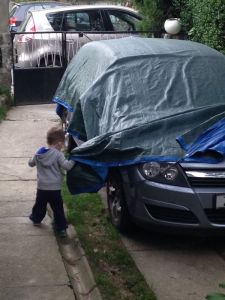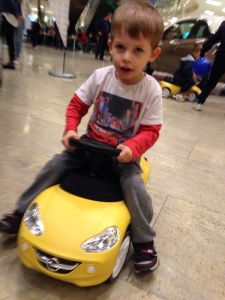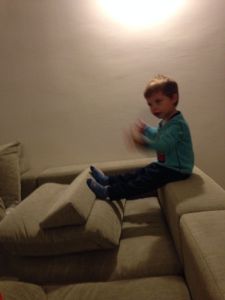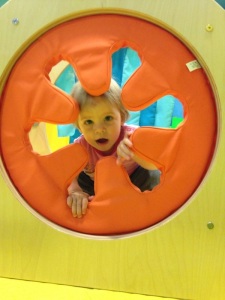Aktivnosti kod kuće
Vaše kuće i stanovi su mjesta koja vaša djeca najbolje poznaju. Oni će se uvijek malo drugačije ponašati kod kuće nego na drugim mjestima. Djeca kojoj se tjelesna shema nije do kraja razvila, bit će opuštenija i osjećat će se zaštićenije u okolini koja im je poznata. Tako da će isprobavanje novih aktivnosti bolje proći kod kuće.
Znamo da kada ste kod kuće, najvjerojatnije morate zbrinuti i kućanstvo; rublje, suđe, doručak, ručak, večeru (osobito ako Vaše dijete ili neki drugi član obitelji treba specijalnu prehranu), čišćenje itd. Stoga je razumljivo da se ne možete konstantno igrati s djetetom. I to je ok! Ali, to ne znači da dijete ne može dobiti senzorne podražaje koji mu trebaju. Učinite svoj dom senzorno podražljivim i dopustite djetetu da samo traži podražaje iz prostora koji mu trebaju. No, pazite da ne prestimulirate Vaše dijete. Važno je imati na umu koliko je svako dijete posebno i kako drugačije reagiraju na svaku aktivnost. Jedno te isto dijete može različito reagirati na isti podražaj u različito vrijeme. Ono što je bilo zabavno ujutro može postati najgori neprijatelj već za pet minuta ili do kraja dana. I to je isto u redu! Lakše je reći nego to napraviti, ali sve što morate raditi je promatrati svoje dijete kroz senzornu prizmu.
Možete dijelove vaših domova ili dječje sobe osposobiti za određeni podražaj (taktilni, vestibularni…). Neki roditelji su čak napravili senzorne sobe u svojim podrumima. To će omogućiti Vašem djetetu da neometano pronalazi podražaje koji mu trebaju. No, s obzirom da je cilj da integriramo podražaje, uvijek možemo jednu igru ili podražaj malo začiniti. Ako se Vašemu djetetu ljulja ili vrti ili poželi hodati na nečemu visokome, vrlo vjerojatno traži vestibularni podražaj. Dopustite mu to na trenutak ili dva te ga polako angažirajte na novu aktivnost, dok još prva traje: na pjesmicu ili aktivnost istraživanja tijela ili na nešto vizualno.
Da pojasnim: dok se Vaše dijete ljulja, možete mu dati da baca jastučiće različite težine u košaru ili da pjeva pjesmicu u ritmu ljuljanja. Ako nemate ljuljačku, jednostavno stavite dijete na deku i ljuljate ga u različitim smjerovima i ritmovima. Također, pitajte svoje dijete želi li još te čekajte na njegov odgovor: u obliku osmjeha, plakanja, ako kaže da ili ne ili bilo kakvom radnjom pokaže svoju volju. Ove aktivnosti mogu biti vrlo kratke – djecu je ponekad dovoljno zaljuljati jednom ili dva puta i to treba poštivati, makar bismo mi rado da se ljuljaju i dalje. Vaše je dijete možda preosjetljivo na ovaj podražaj te ga ne želimo prestimulirati.
Ako trebate obavljati svoje kućanske poslove, a dijete bi trebalo biti samo na neko vrijeme, dajte im neki zadatak za koji mislite da mogu sami uspješno izvršiti bilo u svojoj sobi ili kod Vas u kuhinji. Mogli biste napraviti poligon po kući ili hodniku sa različitim preprekama koje dijete mora proći da bi došlo do Vas. Napravite ga tako da ste sigurni da ga dijete može uspješno proći (ne prelagano, ali niti toliko teško da se bespotrebno frustrira). U sklopu poligona možete i nadodati druge aktivnosti poput pronalaženja igrački ili loptica koje mora skupiti i staviti u košaru na kraju. To će Vašem djetetu dati osjećaj za početak i kraj te će imati cilj koji će im dati osjećaj zadovoljstva. Zato je vrlo bitno napraviti zadatak dovoljno izazovan, ali da ga je moguće prebroditi.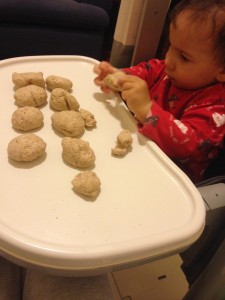
Ako je Vaše dijete premalo da bude samo i mislite da to nije dobro za njegovu sigurnost, neka dijete bude s Vama npr u kuhinji; može se igrati s različitim teksturama hrane kao što su grah, sirova tjestenina, žitarice ili mu možete čak prirediti ljepljivo tijesto od brašna i vode. Ako to tijesto napravite malo žilavijim, može biti dobra proprioceptivna aktivnost gdje dijete mora otkidati male komadiće, napraviti kuglice među vršcima prstiju i npr. zalijepiti te kuglice na komad papira sa unaprijed nacrtanim oblicima (srce, krug, linija, lice..). Naravno, imajte na umu da sve ove namirnice mogu završiti i u ustima Vašeg djeteta pa treba imati dijete na oku i procijeniti je li ova igra sigurna za njega i po pitanju alergija (npr. gluten ili kikiriki).
A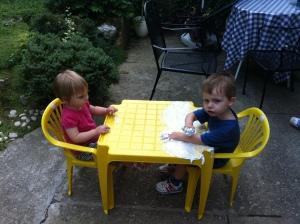 ko ste primijetili da Vaše dijete ne voli imati prljave ruke, onda će iduća aktivnost biti vrlo izazovna za Vaše dijete i možda će mu biti potrebno i nekoliko mjeseci da prihvati pa probajte aktivnost uvoditi postepeno – igra s pjenom. Pjena je vrlo taktilno stimulirajuća koju mnoga djeca s odstupanjem u taktilnoj obradi isprva ne mogu podnijeti. To se često dogodi jer pjena nema čvrste granice i rubove koje daju informacije našem mozgu o tom predmetu pa tako pjena vrlo lagano klizi kroz prste i mozak ju ne može s lakoćom definirati. Može biti toliko zastrašujući osjećaj da se pojavi nagon za povraćanjem. Idite polako i postepeno i nemojte forsirati dijete. S pjenom se možete igrati na ogledalu ili npr na staklenim vratima te crtati prstićima različite oblike, crteže ili raditi otiske. Neka djeca su slabije osjetljiva i na okus pa im je pjena za brijanje zbog svog snažnog mirisa vrlo privlačna za istraživanje ustima. Imajte i to na umu kada dajete djetetu da se igra s pjenom (kao alternativu, možete koristiti šlag ako Vaše dijete to smije staviti u usta).
ko ste primijetili da Vaše dijete ne voli imati prljave ruke, onda će iduća aktivnost biti vrlo izazovna za Vaše dijete i možda će mu biti potrebno i nekoliko mjeseci da prihvati pa probajte aktivnost uvoditi postepeno – igra s pjenom. Pjena je vrlo taktilno stimulirajuća koju mnoga djeca s odstupanjem u taktilnoj obradi isprva ne mogu podnijeti. To se često dogodi jer pjena nema čvrste granice i rubove koje daju informacije našem mozgu o tom predmetu pa tako pjena vrlo lagano klizi kroz prste i mozak ju ne može s lakoćom definirati. Može biti toliko zastrašujući osjećaj da se pojavi nagon za povraćanjem. Idite polako i postepeno i nemojte forsirati dijete. S pjenom se možete igrati na ogledalu ili npr na staklenim vratima te crtati prstićima različite oblike, crteže ili raditi otiske. Neka djeca su slabije osjetljiva i na okus pa im je pjena za brijanje zbog svog snažnog mirisa vrlo privlačna za istraživanje ustima. Imajte i to na umu kada dajete djetetu da se igra s pjenom (kao alternativu, možete koristiti šlag ako Vaše dijete to smije staviti u usta).
Za djecu koja su slabije osjetljiva na taktilni i proprioceptivni podražaj, pokušajte nabaviti ili napraviti neravne podloge koje ćete staviti na mjesto gdje se Vaše dijete najviše igra. Mi koristimo sobnu plažu Dr. Stošića koju možete kupiti, a alternativno možete i napraviti svoju npr. od plutenih čepova.
Uzmite presvlaku za prekrivač te ju napunite malim lopticama ili granuliranim stiroporom. Ovo će onda biti sigurno mjesto gdje Vaše dijete može skakati (ako su loptice mekane!), prekoračavati, prepuzavati, valjati se ili jednostavno ležati. Ili samo dajte svojim vrečama-sjedalicama punjenim stiroporom novu ulogu.
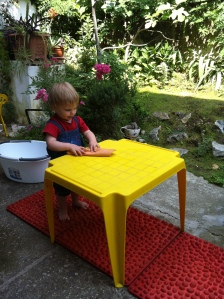

 what is not so obvious is that parks or some green areas in your neighborhood have tree leaves that are especially in the Fall season colorful (visual), they make noise (audio), if taken in hand they can be a great source of tactile input. Some are dry and make a crisp sound, others are wet and usually not well appreciated among both kids and adults. Who wants dirty hands, right? If your child doesn’t speak, you can help him/her imitate the shhhh sounds of those leaves, too. If you take a few beautiful and colorful leaves home, you can make some creative art. From unusual decorations on a gift box, or sorting them by color or size to making them into powder (the dried ones) and using it to form new shapes (gluing the powder on paper in a shape, mixing it with water etc). I tried making an Indian coloring art called rangoli out of different colors of fallen leaves. Unfortunately I don’t have a photo to share with you. So, all this is just from leaves, and we didn’t even enter a park!
what is not so obvious is that parks or some green areas in your neighborhood have tree leaves that are especially in the Fall season colorful (visual), they make noise (audio), if taken in hand they can be a great source of tactile input. Some are dry and make a crisp sound, others are wet and usually not well appreciated among both kids and adults. Who wants dirty hands, right? If your child doesn’t speak, you can help him/her imitate the shhhh sounds of those leaves, too. If you take a few beautiful and colorful leaves home, you can make some creative art. From unusual decorations on a gift box, or sorting them by color or size to making them into powder (the dried ones) and using it to form new shapes (gluing the powder on paper in a shape, mixing it with water etc). I tried making an Indian coloring art called rangoli out of different colors of fallen leaves. Unfortunately I don’t have a photo to share with you. So, all this is just from leaves, and we didn’t even enter a park!


